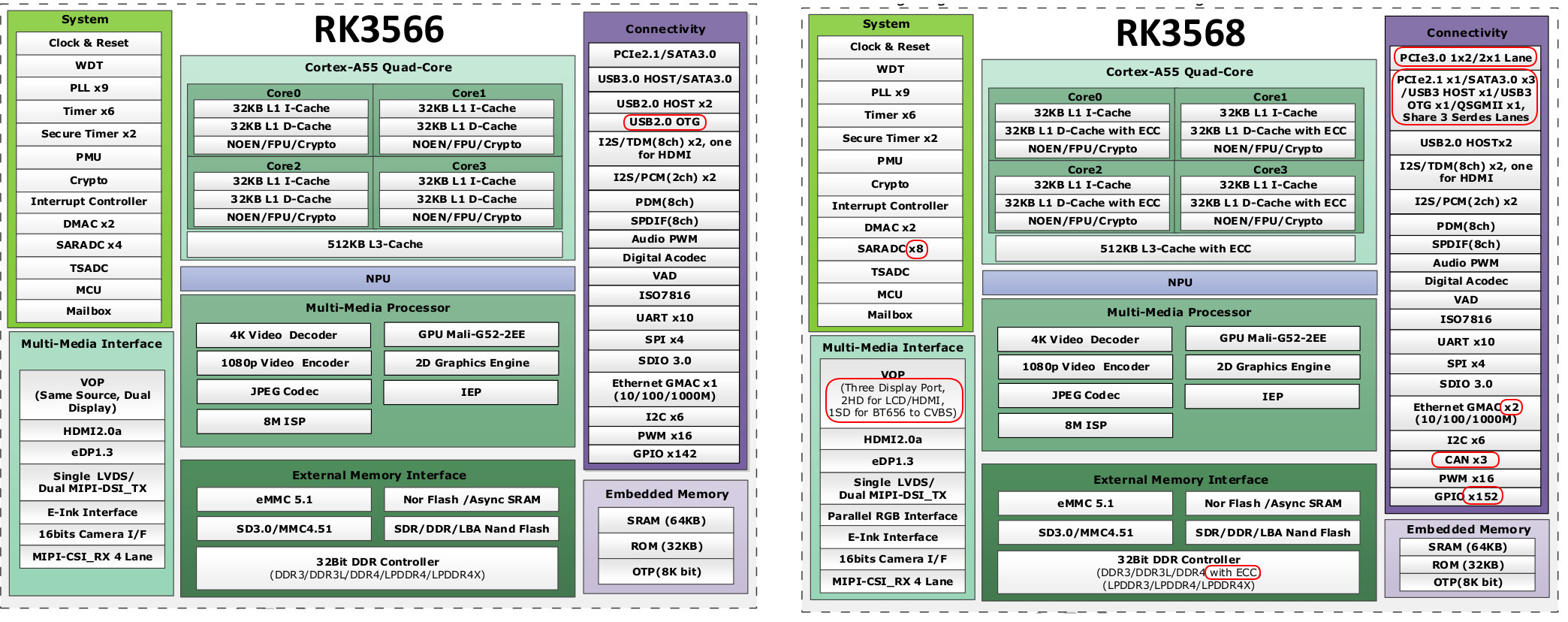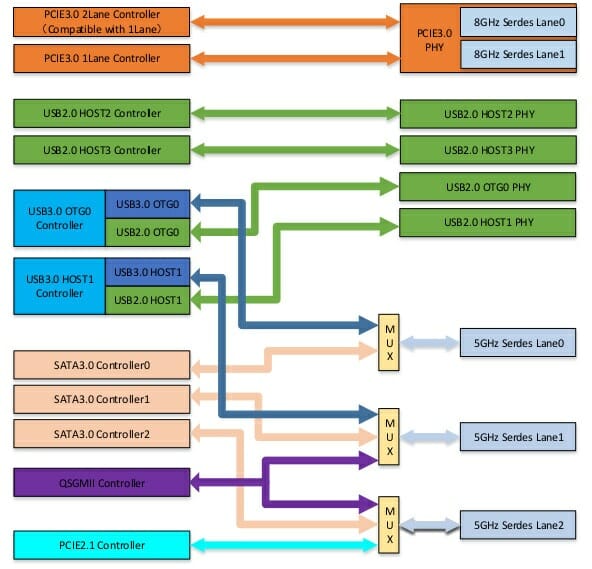We first covered Rockchip RK3566 processor in February, but we’ve been informed the specifications have changed since then, and earlier this month, we also wrote about RK3568 quad-core Cortex-A55 processor with the same base features but some extra I/Os.
But due to NDAs, people familiar with the chips could not release too many details, so we did not get the full picture. This has just changed as the datasheets for both processors have just dropped from somewhere here and there, and we can get a much closer look.
RK3566 and RK3568 specifications

Rockchip RK3566 | Rockchip RK3568 |
|
|---|---|---|
| CPU | Quad-core Cortex-A55 |
|
| GPU | Mali-G52 EE |
|
| AI accelerator | 0.8 TOPS NPU |
|
| Memory | DDR3/DDR3L/DDR4 LPDDR3/LPDDR4/LPDDR4X | DDR3/DDR3L/DDR4 with ECC, LPDDR3/LPDDR4/LPDDR4X |
| Storage | NOR flash, SPI NAND, eMMC 5.1 , SATA 3.0, 8K OTP | NOR flash, SPI NAND, eMMC 5.1 , 3x SATA 3.0, 8K OTP |
| Display I/F | RGB, LVDS or MIPI DSI, HDMI 2.0a, eDP 1.3, e-Ink; dual-display support | RGB, LVDS or MIPI DSI, HDMI 2.0a, eDP 1.3, e-Ink; triple display support |
| VPU | Video decode – 4Kp60 H.264/H.265/VP9 Video encode – 1080p60 H.264/H.265 |
|
| Camera I/F | 8M ISP with HDR 4-lane / 2x 2-lane MIPI CSI2 @ 2.5 Gbps per lane 16-bit DVP camera support with BT.656/601/1120 |
|
| Audio | 8-channel I2S/TDM, 2x 2-channel I2S 8-channel PDM S/PDIF out |
|
| Networking | 1x Gigabit Ethernet (GMAC) | 2x Gigabit Ethernet (GMAC) Quad serial gigabit media-independent interface (QSGMII)* |
| USB | 2x USB 2.0 host, 1x USB 2.0 OTG, USB 3.0 host | 2x USB 2.0 host, USB 3.0/2.0 OTG, USB 3.0 host |
| PCIe | PCIe 2.1 1x1 lane | PCIe 2.1 1×1 lane PCIe 3.0 1×2 lane or 2x 1-lane @ 8 Gbps |
| Other I/Os | SDIO 3.0 10x UART, 4x SPI, 16x PWM, 6x I2C, 2x SARADC | SDIO 3.0 10x UART, 4x SPI, 16x PWM, 6x I2C, 3x CAN FD, 8x SARADC |
| Package | FCCSP565L (body: 15.5mm x 14.4mm; ball size: 0.3mm; ball pitch: 0.65 & 0.4mm) | FCBGA636L (body: 19mm x 19mm; ball size: 0.3mm; ball pitch: 0.65mm) |
Multiplexed interfaces.
Important note. Rockchip RK3566 and RK3568 are using Multi-PHY Interfaces, and while the table above lists all possible interfaces, they can not all be used at the same time. PCIe, SATA, USB 3.0 are multiplexed in most cases as shown in the diagram below for RK3568.

There are a fair amount of differences, and notably, both processors are not pin-to-pin compatible, so the upcoming Pine64 RK3566 SBC can not be easily upgraded to RK3568. People interested in ECC memory support will have to go with the latter, and so the ones wanting multiple SATA interfaces, PCIe 3.0 support, CAN bus, and/or dual Gigabit Ethernet.
Update: You can check our post about RK3566 benchmarks on Android 11 for more information about performance.

Jean-Luc started CNX Software in 2010 as a part-time endeavor, before quitting his job as a software engineering manager, and starting to write daily news, and reviews full time later in 2011.
Support CNX Software! Donate via cryptocurrencies, become a Patron on Patreon, or purchase goods on Amazon or Aliexpress




